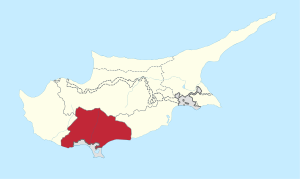Pelendri
Pelendri (Greek: Πελένδρι, Turkish: Pelendri) is a village in the Limassol District of Cyprus.
Pelendri Πελένδρι Pelentri or Pelendria | |
|---|---|
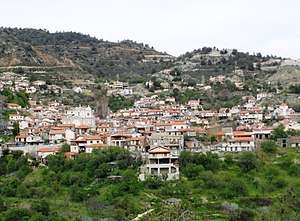 Pelendri village | |
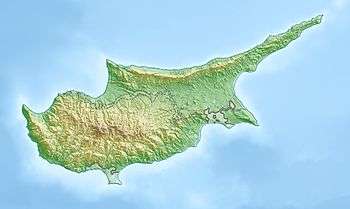 Pelendri Location in Cyprus | |
| Coordinates: 34°53′45″N 32°57′54″E | |
| Country | |
| District | Limassol District |
| Population (2001)[1] | |
| • Total | 1,185 |
| Time zone | UTC+2 (EET) |
| • Summer (DST) | UTC+3 (EEST) |
| Website | www |
Location
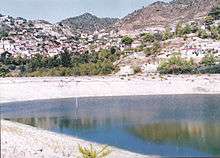
Pelendri is located below the Troodos Mountains, in the region of Pitsilia. It is located on a barren hillside, at an altitude of 800 meters above sea level, 40 kilometers from the city of Limassol. Adjacent to the Trimiklini villages Saittas, Potamitissa and Amiandos.
Physical geography
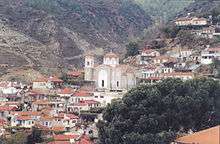
Geology
The terrain is rugged and mountainous with narrow deep valleys and steep slopes. On three sides of the village loom tall peaks, their height in many cases exceeding 1000 metres.
Climate, flora and vegetation
The climate of the region combined with the relatively high annual rainfall received by the village (about 750 millimetres) favours the cultivation of various fruit trees (apple, peach, pear), grapevines, olive, almond, nuts, raspberries and vegetables (green beans, peas, tomatoes, cucumbers, onions, zucchini, potatoes).
However, due to the relief of the area there are several uncultivated areas with a rich presence of natural vegetation. Here there are a variety of plants: πεύκων, λατζιές, αντρουκλιές, τρεμιθιές, ξυσταριές, περνιές, αγριοελιές, σκλήδρους, πλατάνους, μερσινιές. Part of the Troodos and Monastery state forests are within the administrative boundaries of Pelendri.
History
Pelendri was a well-known settlement during the Middle Ages. Louis de Mas Latrie refers to it as Pelendres or Pelondres. He also says that in 1353 it was a fief of John de Lusignan, Prince of Antioch and a member of the royal family of Cyprus. The medieval chronicler Georgios Boustronios mentioned the village twice in his chronicle. In one case he mentions that in around 1461, a rich trader named Satin lived in the village. In the second, he speaks of two Prastio (farms) in Pelendri owned by Ritzzo di Marino. They were seized in 1474 by Catherine Cornaro. These two farms, Kardamas (Kardama) and Filagra, were dissolved during the Ottoman occupation. Filagra was re-established in the mid 20th century.
According to narratives, there were still 14 small villages in the area. They were abandoned, their residents joining with those of Pelendri for security. As such villages reads: Poulos, in which many important archaeological artefacts of the era of Alexander the Great were found, Fournia, in which there are traces of old settlement, Troumithos, in which there is a very old chalcopyrite mine, the Tzeramis, which was completely destroyed by a landslide, Rontia, Konnara, Kaminia, Mazokampos, Chalazin, Argyrou, Deisis, Ais Giannis Potamoulion, Pontikia and Kountouries.
Population history
| Census | Population | Comments | Diagram |
|---|---|---|---|
| 1881[2] | 444 | The census does not distinguish the inhabitants according to their religion or nationality. |
 |
| 1891[3] | 515 | 514 non-Muslims, 1 Muslim. | |
| 1901[4] | 579 | Only non-Muslims. | |
| 1911[5] | 715 | 714 non-Muslims, 1 Muslim. | |
| 1921[6] | 798 | 798 non-Muslims, 1 Muslim. | |
| 1931[7] | 982 | 982 Christians, 1 Muslim. | |
| 1946[8] | 1504 | 1503 Greeks Orthodox, 1 Muslim Turkish. | |
| 1960[9] | 2094 | Only Greeks. | |
| 1973[10] | 2253 | Only Greek Cypriots. | |
| 1976[11] | 2218 | Only Greek Cypriots. | |
| 1982[12] | 1739 | Only Greek Cypriots. | |
| 1992[13] | 1377 | Only Greek Cypriots. | |
| 2001[14] | 1185 | Only Greek Cypriots. | |
| 2011[1] | 1074 | Only Greek Cypriots. | |
| The comments refer to the separation of the residents according to their religion or nationality as it was in the corresponding census. Data for the diagram from wikidata. | |||
References
| Wikimedia Commons has media related to Pelendri. |
- "Cyprus census 2011" (in Greek). Nicosia: Statistical Service of Cyprus. 2015-11-17. Sheet Γ1. Archived from the original (XLS) on 2017-05-01. Retrieved 2017-05-01.
- "Census of Cyprus 1881" (PDF). 1884. p. 13. Archived from the original (PDF) on 2017-05-01. Retrieved 2017-04-30.
- "Census of Cyprus 1891" (PDF). June 1893. p. 12. Archived from the original (PDF) on 2017-05-01. Retrieved 2017-04-30.
- "Census of Cyprus 1901" (PDF). p. 11. Archived from the original (PDF) on 2017-05-01. Retrieved 2017-04-30.
- "Census of Cyprus 1911" (PDF). p. 11. Archived from the original (PDF) on 2017-05-01. Retrieved 2017-04-30.
- "Census of Cyprus 1921" (PDF). 1922. p. 11. Archived from the original (PDF) on 2017-05-01. Retrieved 2017-04-30.
- "Census of Cyprus 1931" (PDF). 1932. p. 9. Archived from the original (PDF) on 2017-05-01. Retrieved 2017-04-30.
- "Census of Cyprus 1946" (PDF). 1949. p. 7. Archived from the original (PDF) on 2017-05-01. Retrieved 2017-04-30.
- "Census of Cyprus 1960" (PDF). p. 15. Archived from the original (PDF) on 2017-05-01. Retrieved 2017-04-30.
- "History". www.pelendri.org. Archived from the original on 2017-05-19. Retrieved 2017-05-19.
- "Census of Housing 1976" (in Greek). Statistical Service of Cyprus. Archived from the original on 2017-05-01. Retrieved 2017-04-30.
- "Census of Housing 1982". Statistical Service of Cyprus. Archived from the original on 2017-05-01. Retrieved 2017-04-30.
- "Cyprus census 1992" (in Greek). Statistical Service of Cyprus. Archived from the original on 2017-05-01. Retrieved 2017-04-30.
- "Cyprus census 2001" (in Greek). Statistical Service of Cyprus. 2002-11-18. Archived from the original on 2017-05-01. Retrieved 2017-05-01.
